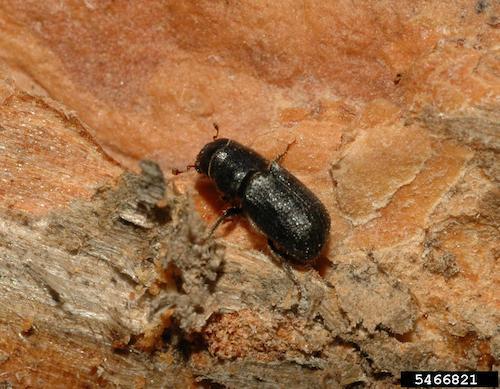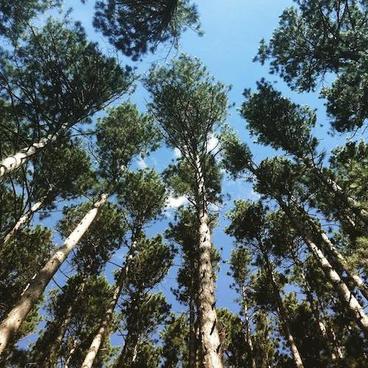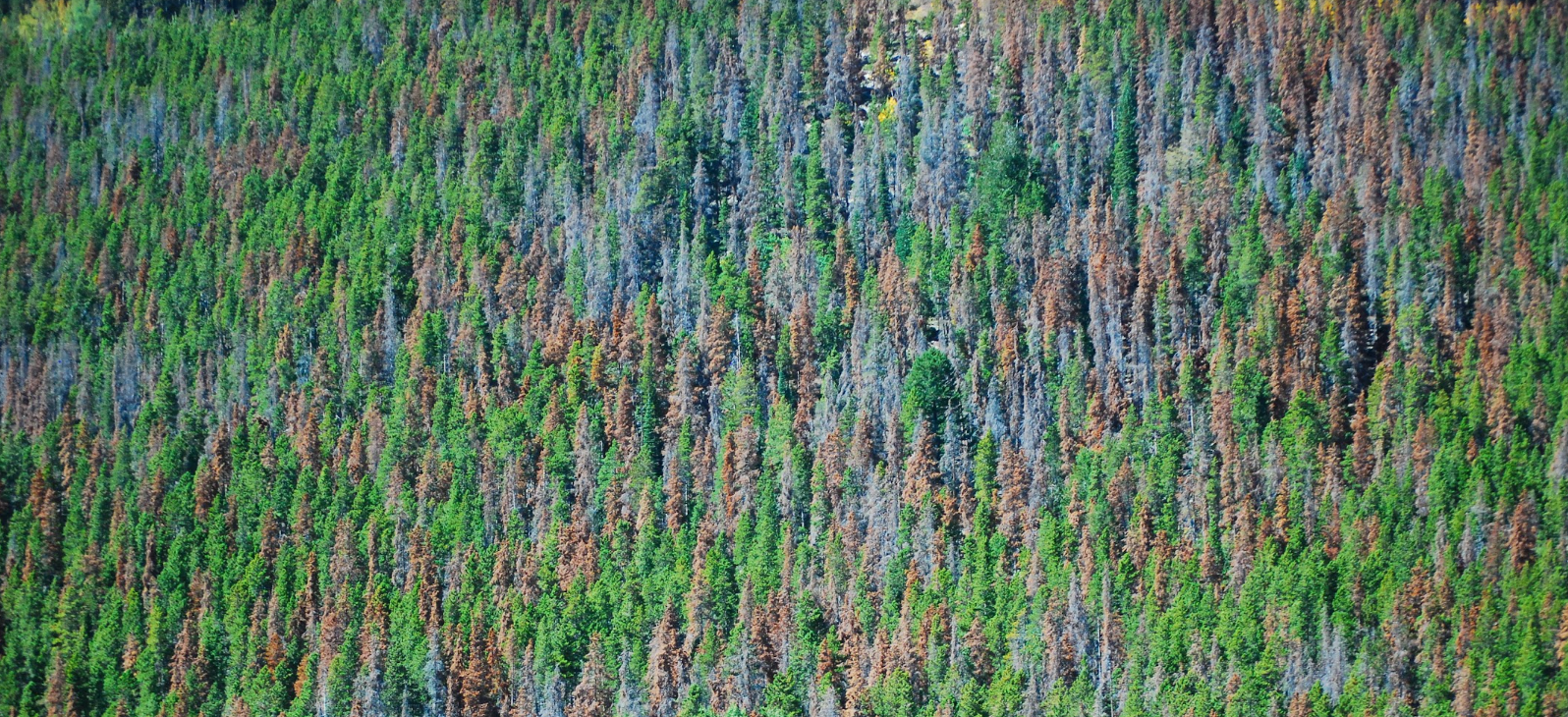MITPPC-funded researchers are preparing for the impending arrival of a top threat to Minnesota’s trees.
by Carolyn Bernhardt, MITPPC communications specialist

For decades, the mountain pine beetle (MPB) has caused an unprecedented amount of forest mortality in western North America, tearing through pine stands from the Pacific Coast all the way to the Black Hills of South Dakota, and from central British Columbia and western Alberta to northern Baja California, Mexico. These black, pearlescent bark beetles destroy pine stands by mass attacking trees, carving extensive galleries beneath the bark. They also spread diseases through forests by carrying fungi and other pathogens with them from tree to tree. And one day soon, the pest could very well knock on Minnesota’s door.

Studies show that a warming climate has paved the way for the species to expand its range, which means grotesque trends of MPB’s outlandish destruction are likely to continue with projected climate changes across the country. Meanwhile, the vast pines of northern Minnesota are vital to the ecology and economy of the state, but a warming climate, unprecedented beetle numbers, and firewood and timber transport could help this destructive forest pest make its way across the United States or Canada to Minnesota. That’s why, even though researchers have yet to find mountain pine beetle in the state, the Minnesota Invasive Terrestrial Plants and Pests Center (MITPPC) has ranked it as the #1 top invasive insect priority for research funding.
With additional support from the Albert Victor Ravenholt Fund, MITPPC funds researchers at the University of Minnesota as they work to prevent the beetle from arriving and prepare for what would happen if it does. These MITPPC scientists, led by Brian Aukema, PhD, a professor in the Department of Entomology in the College of Food, Agricultural, and Natural Resource Sciences, have been working to forecast how the mountain pine beetle might fare in Minnesota. This research offers critical support for quarantine measures taken by the Minnesota Department of Agriculture to keep the insect out of the state. It also helps land managers more accurately weigh their level of concern about this pest.
The search for natural enemies
Once in Minnesota, the mountain pine beetle would encounter a different competitive landscape than what it's been previously exposed to in other ecological contexts. While MPB has adapted to new environments previously, these Minnesota-specific obstacles would be altogether new to the pest. For one thing, MPB would have to adapt to an environment with pine tree species it has never faced before. Additionally, the insect would overlap with local species of native bark beetles, such as the eastern five-spined ips bark beetle, and have to compete with these beetles for resources.
“Our goal is to help determine whether Minnesota’s native natural enemies that [compete with] native bark beetles would [also] recognize and respond to mountain pine beetle pheromones,” says Aukema. Anticipating how the beetle would fare in this new context can help hone bio-control measures and other management strategies that Minnesota can get started on before the insect arrives.
However, after baiting some logs of jack pine trees in the Black Hills with pheromones of the five-spined ips bark beetle, some with pheromones from the mountain pine beetle alone, and some with a combination of the two, the team observed that the five-spined bark beetle avoids logs baited with pheromones of mountain pine beetle. Meaning, the two species would be unlikely to cross paths.
As a result, the team suspects that MPB might respond to pheromones from the five-spined ips bark beetle only as a “last-ditch” effort to find habitat during certain periods where there are insufficient numbers of fellow mountain pine beetles to mass-attack, colonize, and kill large trees. “If this suspicion is true, mountain pine beetle could potentially find an endemic niche in Minnesota’s pine forests,” Aukema says. In other words, the mountain pine beetle might be lurking in Minnesota forests at low densities, perhaps causing little to no damage. But if those trees experience stress, such as drought, mountain pine beetles could increase to tree-killing outbreak levels, causing widespread tree mortality.
The MITPPC-funded researchers also know MPB would have to contend with a considerable amount of competition from other native wood-boring insects, too, such as long-horned beetles. Long-horned beetles feed aggressively underneath tree bark and could, in theory, inadvertently destroy MPB brood while munching away. Aukema had hoped these and other insects might make it more difficult for MPB to gain a foothold in Minnesota by responding to the same pheromones released by MPB when colonizing a tree.
Unfortunately, Aukema says, “We found that insects in the Great Lakes region may not optimally recognize mountain pine beetle aggregation pheromones if the insect were to arrive.” Without this pheromone response, it's unlikely the long-horned beetle and other bark beetle competitors would purposely feed in trees hosting the mountain pine beetle. The team published these findings in Forest Ecology & Management in October 2021. With these two native insect options for managing MPB largely ruled out, the team has turned to forecasting how Minnesota trees might respond to being invaded by the pest.

Anticipating tree susceptibility in Minnesota
Grasping how Minnesota trees might respond to MPB could help scientists foresee where MPB might establish in the state and how severe its impacts might be. The team inoculated a stand of Scots and Ponderosa pine trees in the Black Hills with a fungus MPB carries with it, Grosmannia clavigera, to compare how the two tree species reacted. Based on the chemicals the live Scots pine trees released as a part of their response to the fungus, the team concluded that live Scots pine trees might be able to mount a defense against MPB—an outcome not suggested by initial research with cut logs.
Whether the defensive response is sufficient to stop MPB remains unclear, though. However, in order for the pest to access Minnesota trees in the first place, it has to travel fairly far. So, the research team has also looked into probable mechanisms MPB might use to get here.
Measuring MPB’s tenacity for travel
Research has long shown that humans transport invasive bark beetles and wood borers burrowed inside logs and bark by transporting firewood and timber. Minnesota has previously enacted a quarantine on timber imports after a scare where many dead MPB insects were found under the bark of wood brought to the state from South Dakota. But if MPB can travel far and wide on its own, how much would this strategy really help fend off an invasion?
That’s why this team of MITPPC-funded researchers investigated how far the beetles can travel on their own. During the summer of 2021, the team tested pine forests around Missoula, Montana, and into the grassland range to the east, as well as the Northwestern Black Hills of South Dakota using a trap line that radiated from eastern Wyoming to the eastern border of Badlands National Park.
In previous research, MITPPC scientists noticed that the mountain pine beetle could travel up to 33 miles away from an infested forest. But this time, they did not see such a wide range for the insect, indicating lower numbers and lower dispersal pressure overall. Most likely, this finding was due to the fact that MPB densities can fluctuate considerably from year to year.
Infested forests in South Dakota, which are roughly 500 miles away from the nearest mature pine forests in Minnesota, host the nearest populations. Given this history of findings, Aukema says, “We expect that the risk of mountain pine beetle reaching Minnesota by blowing in from the Black Hills is extremely low.”
Future directions
But if the mountain pine beetle did manage to reach Minnesota on its own, would the species likely be too depleted of energy reserves to overcome natural obstacles—new tree species with different immune responses, new competition species, and new predators—already in place here? Aukema and team's future research aims to help clarify.
The MITPPC scientists hope to investigate whether beetles captured far from infested forest lands have lower concentrations of lipids. Lipids help indicate how much “fuel” an insect has after exertion, just like in humans. Measuring those lipids can help scientists estimate the total distance the beetles traveled. Measuring lipid levels in these beetles also offers researchers rough estimates of how traveling long distances impacts the insect’s stamina in surviving other threats after the journey.
While other scientists have done other lipid experiments with MPB, no one has previously tried to test lipids in MPB by analyzing field collected beetles at different distance before. And previously, this MITPPC-funded team tried testing sugars and proteins to better understand the insect’s endurance. While sugars are a great source of energy, they can deplete rapidly. And proteins likely come from muscle tissue, so using them for flight likely comes with a major cost. That means measuring proteins is not as accurate of an indication of the beetle’s state after a long trek. However, lipids contain lots of energy and can be easily stored for future use. Other insects show a decline in lipids after long flights, so it follows that MPB should, too.

“This new research continues to reaffirm the threat MPB poses to the pines of Minnesota,” says Rob Venette, PhD, Director of MITPPC. “We’ve invested in it because we believe it helps inform quarantine regulations, which are critical to keep this insect out of our beloved state.” Monitoring forests for MPB, he says, is also essential to demonstrate that these quarantine regulations are working. “This research has an immediate application to helping keep Minnesota's forests safe.”
“It’s not every day that a funding agency has the capacity to fund proactive research rather than reacting to realized threats, as we so often need to do with invasive species,” says Aukema. “We so appreciate the support of MITPPC and the AVR foundation for investing in this problem, because the data continues to show it is a continuing problem that we need to take seriously.”
Header photo by David Hansen
Scots pine photo by Carolyn Bernhardt
The Minnesota Invasive Terrestrial Plants and Pests Center research is supported by the Environment and Natural Resources Trust Fund, as recommended by the Legislative and Citizen Commission for Minnesota Resources. However, donor support helps MITPPC research reach new heights.